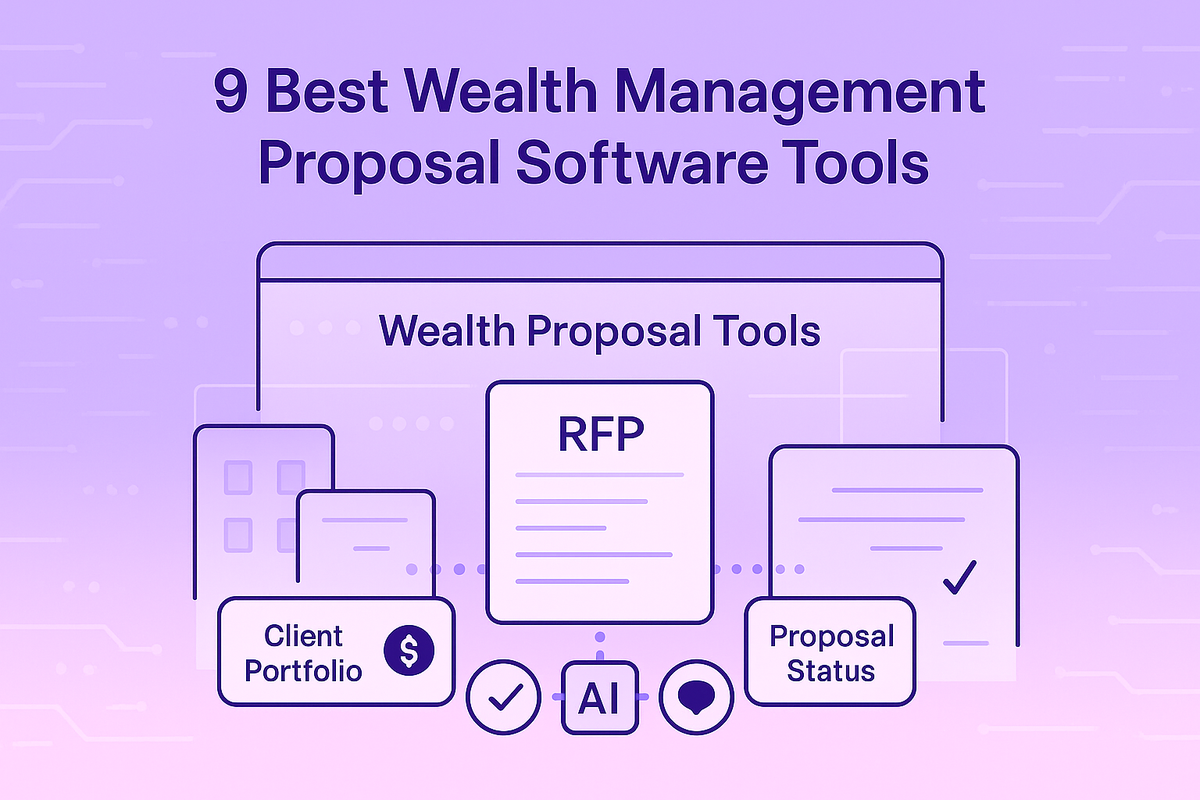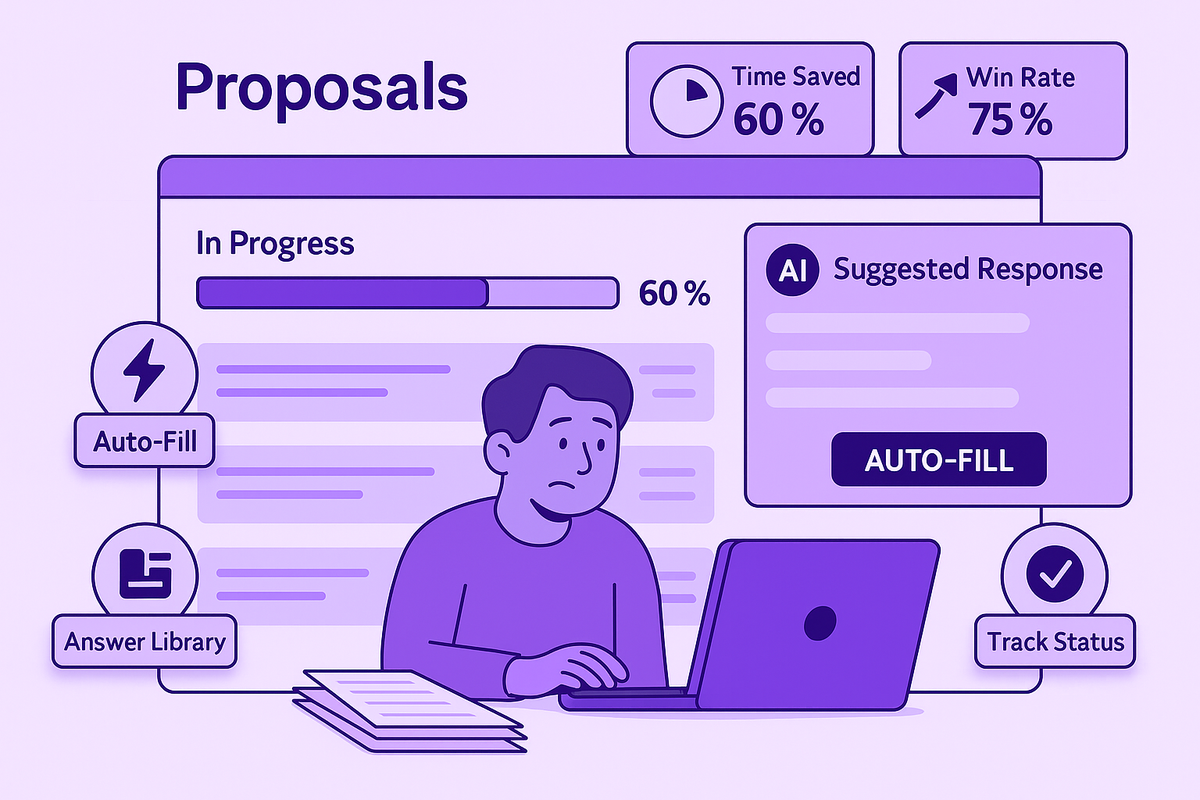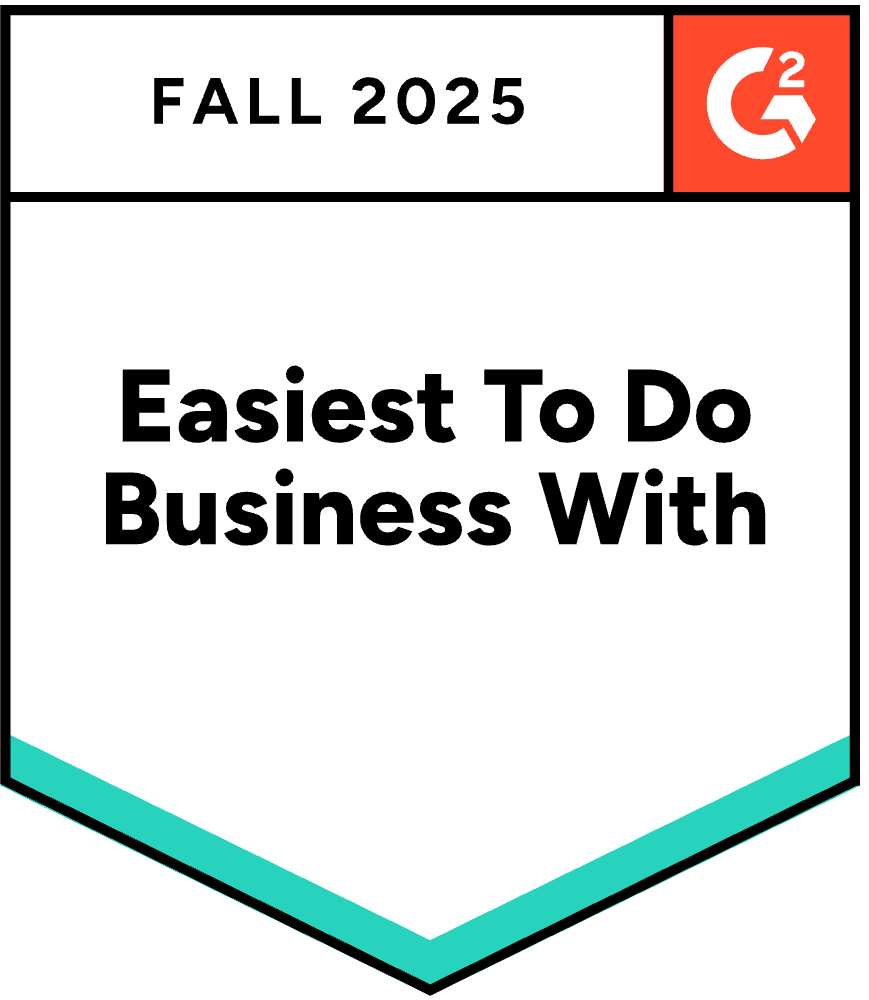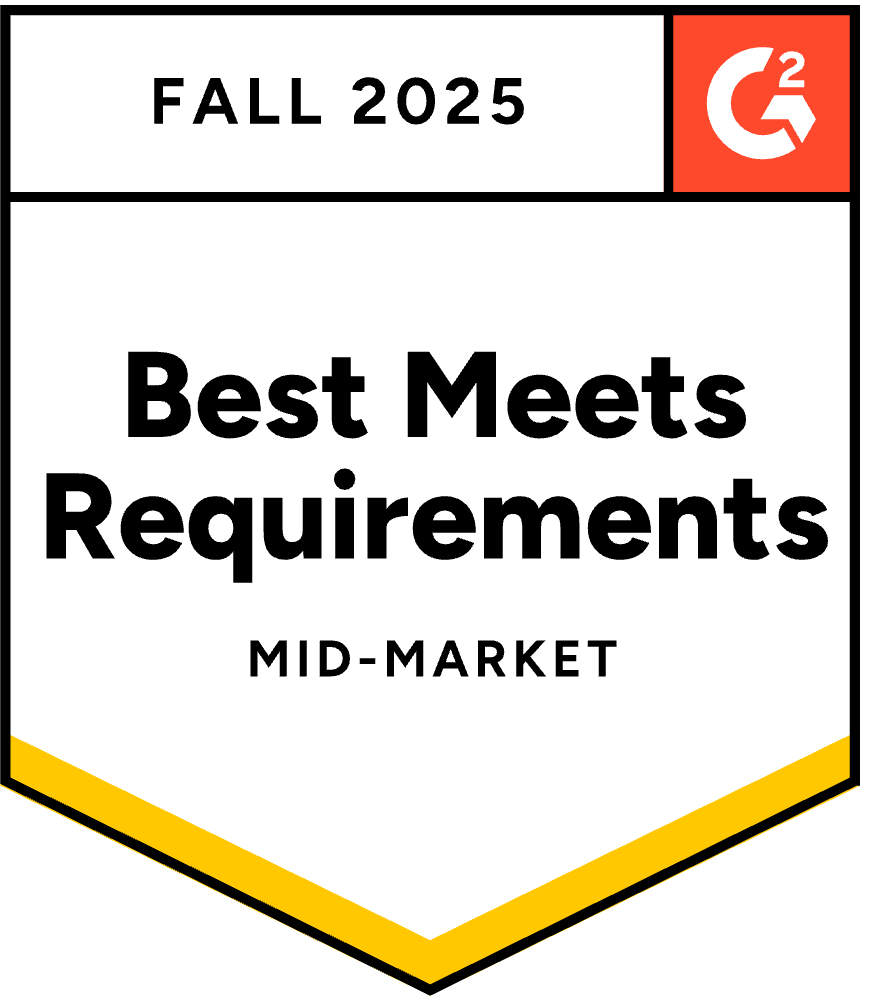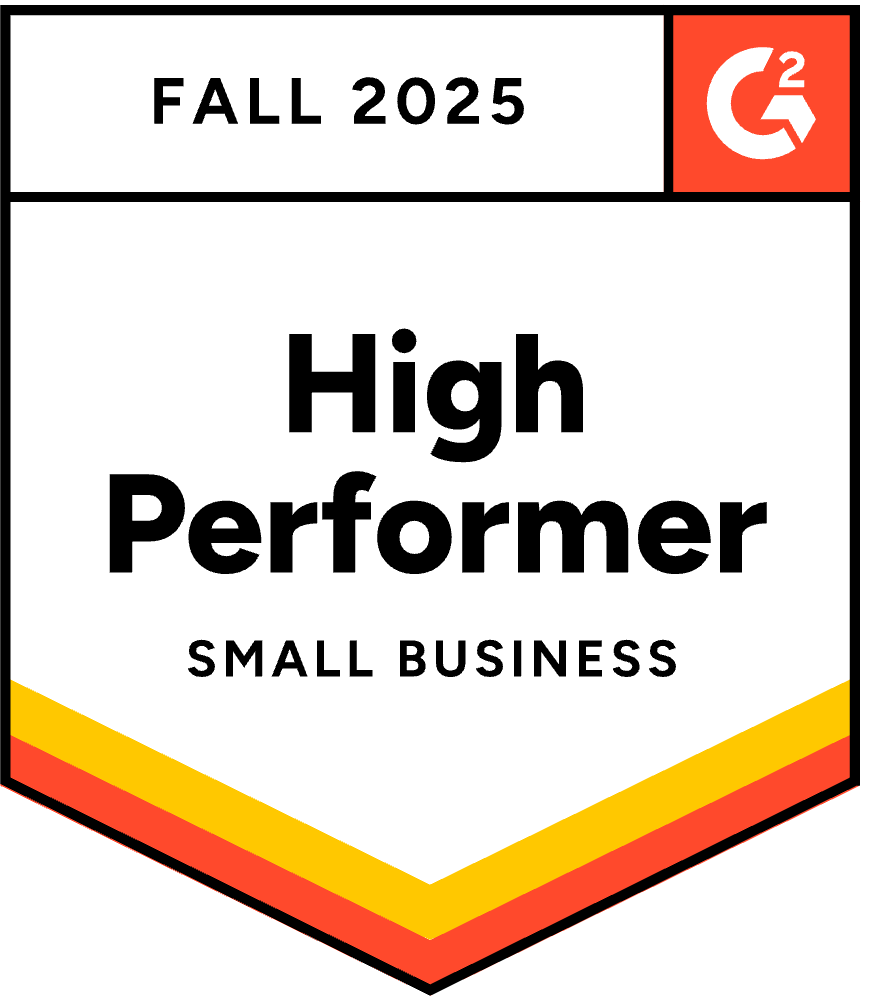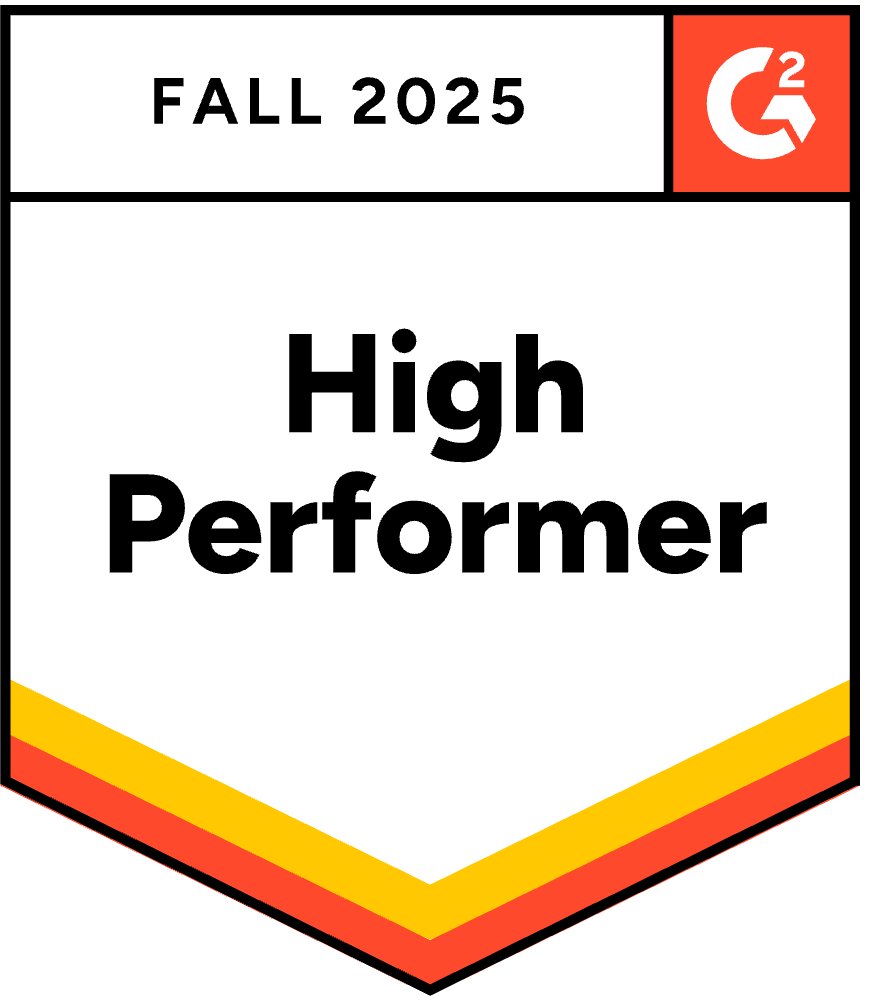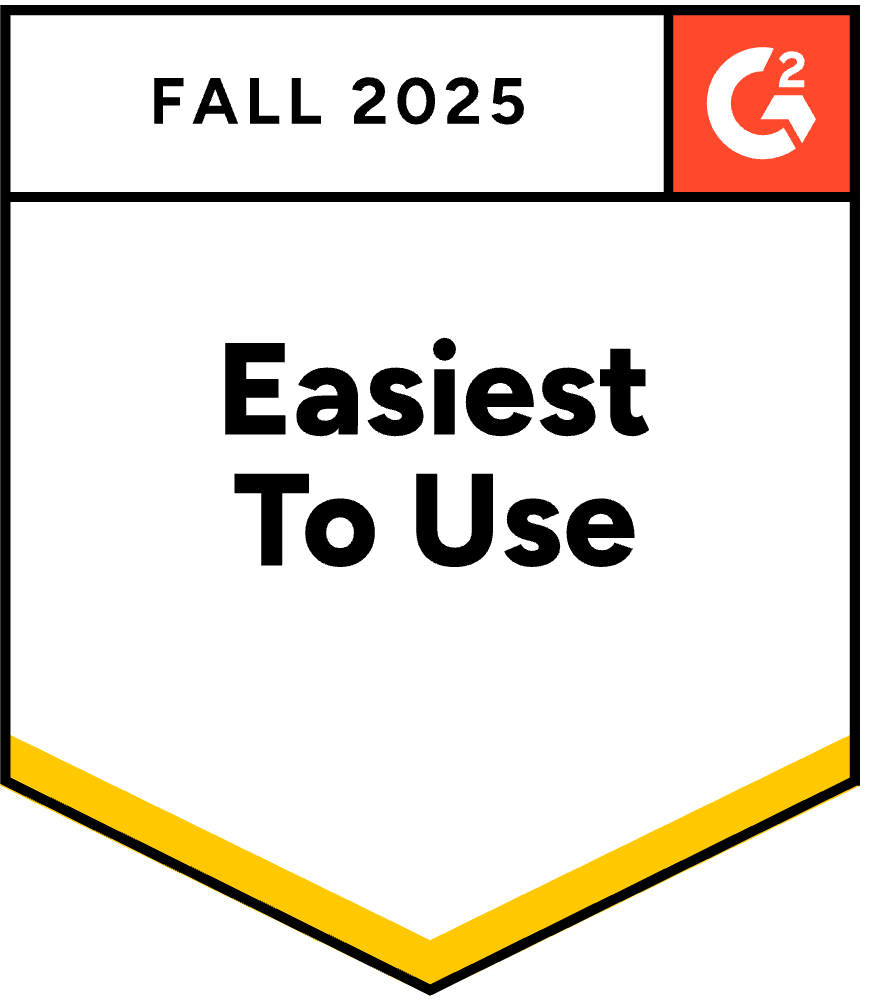Modernize Your RFPs with AI-First Plans
August 28, 2025
By
Evie Secilmis
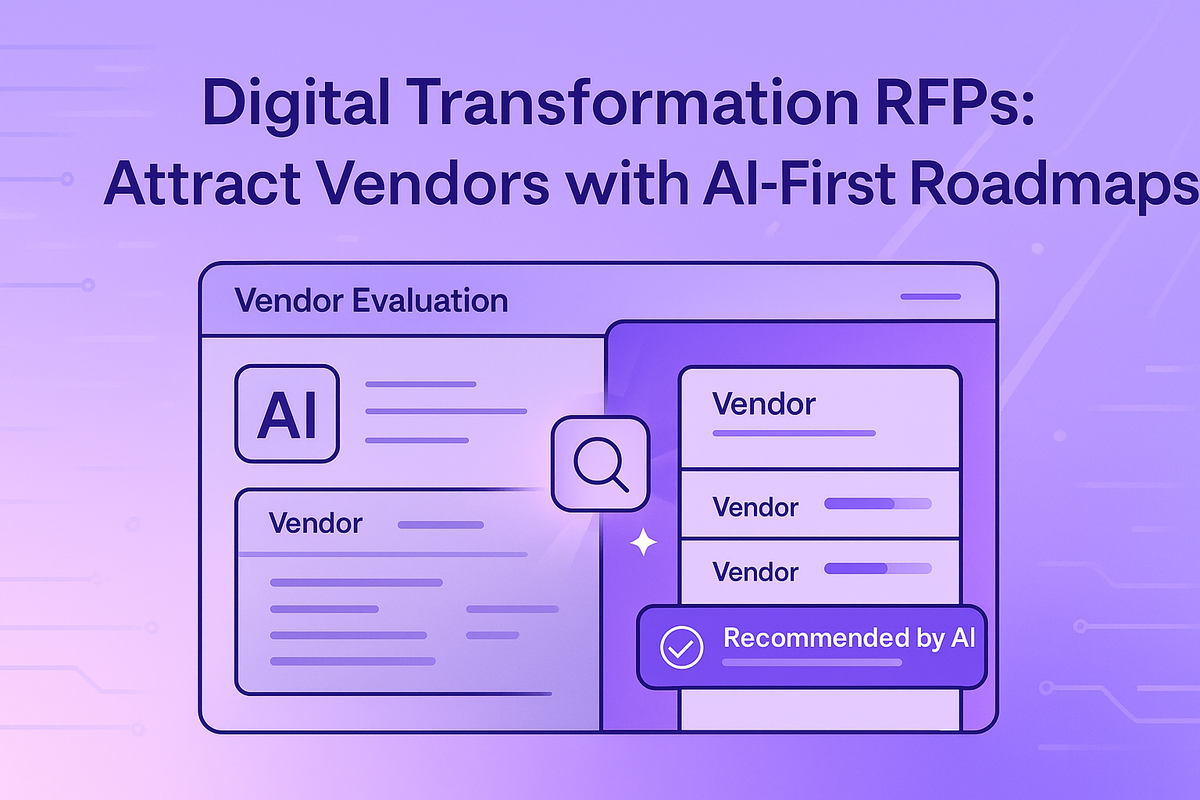
Is your team still managing proposals with a patchwork of spreadsheets, shared drives, and endless email chains? That old way of handling RFPs is slow, error-prone, and a major drain on your resources. This manual process makes it tough to compete for the best deals, leading many to ask, which digital transformation RFPs attract vendors with AI-first roadmaps? The answer: RFPs from companies that value innovation. To win them, you need to show you do, too. This guide explains how to use AI to not only find these deals but also to optimize response quality and transform your entire process from a manual chore into a strategic advantage.
Key Takeaways
- Stop chasing every RFP: Create a clear go/no-go process to decide which opportunities are worth your time. Focusing your efforts on the right bids is the first step to improving your win rate and preventing team burnout.
- Turn chaos into a repeatable process: Treat each RFP response like a well-managed project. By assembling a cross-functional team and implementing a clear review cycle, you ensure every proposal is consistent, accurate, and compelling.
- Use technology to focus on strategy, not busywork: AI-powered RFP software handles the repetitive tasks, like finding approved answers and generating first drafts. This frees your team to concentrate on customizing the proposal and crafting a narrative that wins the deal.
What is an RFP, Really?
If you’re in sales, you’ve likely come across the term RFP. But what does it actually mean? At its core, a request for proposal (RFP) is a formal document an organization uses to announce a project and invite companies to bid on the work. Think of it as a detailed job posting for a specific project. The organization outlines its needs, challenges, and goals, and potential vendors respond with a proposal explaining how their product or service is the best solution.
This process isn't just about finding the cheapest option. It’s a structured way for a company to compare different vendors on a level playing field, looking at everything from technical capabilities to company background and overall value. For your sales team, an RFP is a golden opportunity to showcase your strengths and prove you understand the client’s needs better than anyone else. It’s your chance to tell a compelling story about how you can solve their problem.
The Anatomy of a Strong RFP
When you open an RFP, you'll find it's more than just a simple request. A well-structured document contains several key sections designed to give you all the information you need to submit a thorough proposal. You can typically expect to see a clear description of the project and its goals, background information on the issuing organization, and a detailed "statement of work" that lists the required tasks and timeline. The RFP will also explain the evaluation criteria and provide specific instructions on how to format and submit your proposal. Understanding these components is the first step to crafting a response that ticks all the boxes.
Why Use an RFP?
Organizations use RFPs for a reason, especially for complex or high-stakes projects. The process promotes fair competition by giving multiple companies a chance to bid, which can lead to better pricing and more innovative solutions. For government agencies and large corporations, RFPs are often a required part of their procurement process to ensure transparency and accountability. By issuing an RFP, a company can discover new vendors and creative approaches they might have missed otherwise. For you, this means that even if you don't have a prior relationship with the company, a strong proposal can get your foot in the door.
When is an RFP the Right Choice?
An RFP isn't necessary for every purchase. A company will typically use an RFP when its needs are complex and the solution isn't a simple, off-the-shelf product. It’s the right choice when the buyer wants to understand how a vendor will meet their goals, not just how much it will cost. This process allows them to dig deep into what different sellers can do, compare their approaches, and lower the risk of choosing the wrong partner. When you receive an RFP, it’s a signal that the client is looking for a true partner and values a comprehensive solution over a quick, low-cost fix.
Examples of Common Technology RFPs
Technology RFPs cover a wide range of needs, but you’ll likely encounter a few common types. Many companies issue RFPs for large-scale enterprise software like Customer Relationship Management (CRM) or Enterprise Resource Planning (ERP) systems. These documents are often massive, filled with detailed questions about integration capabilities, data migration, and user training. You'll also see frequent requests for cloud computing services, where the focus is on scalability, security, and service-level agreements. Another major category is cybersecurity, which comes with exhaustive questionnaires about compliance, threat detection, and data protection protocols. Responding to these requires deep technical knowledge and consistency, which is where an AI-powered platform can make a huge difference by quickly finding accurate, approved answers to hundreds of recurring questions.
RFP, RFI, RFQ: Know Your Request Documents
While the RFP often takes center stage, it’s just one of several documents you’ll encounter in the sales cycle. Getting familiar with the entire cast of characters—from RFIs to SOWs—helps you understand exactly what a potential client is asking for and how to position your response for success. Think of it as learning the language of procurement. When you know the difference between a request for information and a request for a quote, you can allocate your team’s time and resources much more effectively. Mistaking an early-stage RFI for a full-blown RFP can lead to wasted hours on a detailed proposal that wasn't even requested. Understanding these nuances allows you to tailor your efforts, meet the buyer where they are in their journey, and build a stronger, more strategic approach to every opportunity that comes your way.
RFP vs. RFI vs. RFQ: What's the Difference?
Let's clear up the alphabet soup. An RFI (Request for Information) is the first step in the process. A company uses an RFI to gather general information about what vendors can offer, often for future planning. They aren't ready to buy yet; they're just exploring the landscape. An RFP (Request for Proposal) comes next. This is where the buyer has a specific problem and wants to see how different vendors would solve it. An RFP invites creative solutions and detailed proposals. Finally, there's the RFQ (Request for Quote). This is the most straightforward of the three. The buyer knows exactly what they want and is simply looking for the best price. The decision here is almost entirely based on cost.
Breaking Down the Statement of Work (SOW)
A Statement of Work (SOW) isn't a request but a foundational project document. It typically comes into play after a vendor has been selected. An SOW is a detailed agreement that outlines everything a project will involve, including the specific tasks, deliverables, timelines, and responsibilities for both parties. It’s the blueprint that ensures everyone is on the same page before any work begins. A well-crafted SOW prevents scope creep and misunderstandings down the line, making it a critical document for a successful partnership. It transforms the promises made in your proposal into a concrete action plan.
What to Know About Due Diligence Questionnaires (DDQs)
Think of a Due Diligence Questionnaire (DDQ) as a background check for your business. These are often used in the final stages of the vendor selection process, especially in industries with strict regulations like finance or healthcare. A DDQ dives deep into your company’s operational and financial health, asking detailed questions about your security protocols, compliance measures, and overall stability. While they can be lengthy and intense, a thorough and transparent response builds a huge amount of trust with a potential client, proving that you’re a reliable and secure partner for the long haul.
The Buyer's Playbook: Understanding the Modern RFP Process
To win more deals, you need to think like a buyer. The RFP process isn't just a series of hoops they make you jump through; it's a structured journey they take to solve a critical business problem. When you understand their motivations, timelines, and the tools they're using behind the scenes, you can stop reacting to requests and start anticipating their needs. This shift in perspective is what separates the teams that consistently win from those that just submit proposals. The modern procurement process is becoming more sophisticated, driven by data and increasingly, by artificial intelligence. Knowing what's happening on the other side of the table gives you a powerful advantage, allowing you to tailor your responses, highlight the right strengths, and build a connection that goes beyond a simple price comparison.
From Problem to Purchase: The Buyer's End-to-End Journey
The buyer's journey begins long before an RFP lands in your inbox. It starts with someone identifying a problem or an opportunity for improvement. From there, a cross-functional team assembles to define the project's scope and requirements. This is a critical phase where they decide what's a "must-have" versus a "nice-to-have." Once they have a clear picture, they'll create the RFP document, a process that can take weeks of internal collaboration. After issuing the RFP, they enter the evaluation phase, where they score responses against their predefined criteria. This often involves multiple rounds of reviews, shortlisting vendors, and conducting demos or follow-up interviews before making a final decision and moving into contract negotiations.
Typical RFP Process Timelines
Patience is a virtue in the RFP world because the process rarely moves as quickly as you'd like. From the moment a company decides to issue an RFP, it can take anywhere from two to four weeks just to create the document. Once it's released, you'll typically have two to four weeks to respond. The evaluation phase is often the longest and most unpredictable, lasting from four to eight weeks as the procurement team wades through submissions and consults with stakeholders. After a vendor is shortlisted, you can expect another one to three weeks for demos and final negotiations. All in, a standard RFP process can easily span three to four months from start to finish.
Why Procurement Teams are Embracing AI
Procurement teams are under constant pressure to reduce costs, mitigate risks, and make smarter decisions—faster. That's why so many are turning to AI. In fact, a staggering 92% of procurement leaders are looking to technology and AI to make their teams more efficient. For them, AI isn't just a buzzword; it's the next logical step in their digital evolution. They started with basic automation to handle simple tasks, moved on to data analysis to find patterns, and now they're using AI to actively improve their processes and guide their decision-making. AI helps them sift through massive amounts of data, identify the best potential partners, and streamline their entire workflow, making them more strategic and less administrative.
How Buyers Use AI to Evaluate Vendors
If you think your proposal is only being read by human eyes, think again. AI is now directly embedded in the RFP process, with adoption rates as high as 90% among some companies. Procurement teams are using AI for a wide range of tasks, from writing the initial RFP questions to automatically scoring your answers based on keywords and sentiment. These tools can quickly flag inconsistencies in your proposal, check your company's financial stability, and even assess potential risks associated with your solution. While direct AI-powered vendor analysis is still an emerging trend, it's growing quickly. This means the clarity, consistency, and accuracy of your responses are more important than ever, as they are increasingly being filtered through an algorithm before they even reach a decision-maker.
The New Rules of Engagement: How AI is Changing the Vendor Landscape
The rise of AI in procurement isn't just changing how buyers buy; it's fundamentally rewriting the rules for how sellers sell. The entire vendor landscape is shifting, and teams that adapt will have a significant competitive edge. AI is leveling the playing field, automating tedious tasks, and allowing for a more data-driven approach to sales. This isn't something to fear—it's an opportunity. By understanding how AI is influencing everything from vendor discovery to final selection, you can adjust your strategy to stand out. It’s no longer just about who you know or the size of your sales team. In this new era, success is about having the right information, presented in the right way, at the right time. And increasingly, technology is the key to making that happen.
How AI is Changing Vendor Discovery
In the past, getting on a buyer's radar often depended on existing relationships or a big marketing budget. AI is changing that. Procurement teams now use intelligent systems to scan the market and identify potential vendors that meet their specific criteria, even if they've never heard of them before. These tools can analyze vast datasets to find companies with the right expertise and track record. For vendors, this means your digital footprint and the clarity of your value proposition are critical. AI also helps buyers automate many of the repetitive tasks in managing RFPs, which allows them to evaluate a larger pool of candidates more thoroughly. This means more opportunities to get your foot in the door, as long as your proposal is clear, concise, and optimized for both human and machine readers.
The High Rate of AI Adoption in Procurement
The pressure on sales teams is mounting. The volume of work involved in strategic responses like RFPs has jumped by 77% in the last year alone. Buyers are issuing more detailed requests and expecting faster turnarounds, all while using AI to scrutinize every detail. Trying to keep up with this demand manually is a recipe for burnout and sloppy work. This is where AI becomes a game-changer for your own team. With a well-organized content library, AI-powered tools can help you complete a first draft up to 80% faster. This isn't about replacing your team's expertise; it's about augmenting it. By automating the search for approved answers and assembling the initial document, AI frees your team to focus on strategy, customization, and telling a story that truly resonates with the buyer's needs.
How Smaller Vendors Can Gain a Competitive Edge
You don't need to be a massive corporation to win big deals. In fact, AI can help smaller, more agile vendors compete effectively against larger incumbents. While you might not have a dedicated proposal team of twenty people, you have other strengths: specialized skills, the ability to offer personalized service, and the flexibility to move quickly. AI-powered RFP software, like what we've built here at HeyIris.ai, acts as a force multiplier for your team. It handles the time-consuming, administrative parts of the response process, allowing your experts to focus on what they do best. This enables you to showcase your unique value, tailor your solution to the client's exact needs, and deliver a high-quality, compelling proposal without the massive overhead.
How to Build a Winning RFP Strategy
A winning RFP response isn’t born from a frantic, last-minute scramble. It’s the result of a deliberate, well-thought-out strategy that begins long before you even receive a request. Think of it as building a strong foundation. When you have a solid plan in place, you can approach each new RFP with confidence and clarity, focusing your energy on the opportunities that are the best fit for your business. This proactive approach helps you move from simply reacting to requests to strategically choosing which deals to pursue.
Building this strategy involves understanding not just the client's needs, but your own team's capacity, strengths, and goals. It’s about creating a repeatable process that ensures every proposal you submit is compelling, accurate, and perfectly aligned with what the client is looking for. By investing time in planning upfront, you can significantly improve your win rates and turn the often-chaotic RFP process into a powerful engine for growth.
Lay the Groundwork with Pre-RFP Planning
The best time to start working on an RFP is before it even exists. Pre-RFP planning is all about getting your house in order so you’re ready to act decisively when the right opportunity comes along. This means establishing a clear "go/no-go" process to quickly evaluate whether an RFP is worth your team's valuable time. Does the project align with your company’s strategic goals? Do you have a genuine chance of winning? Answering these questions honestly prevents you from wasting resources on long-shot bids. This is also the time to organize your content library, ensuring your best answers, case studies, and team bios are up-to-date and easy to find. This preparation is key to optimizing your RFP efficiency from the start.
What Do You Really Want to Achieve?
Before you type a single word of your response, define what a "win" looks like for your team. While securing the contract is the ultimate goal, you should also set internal objectives for the response process itself. For example, your goal might be to submit the proposal two days ahead of the deadline or to ensure every section is reviewed by a subject matter expert. These objectives help keep your team aligned and focused. Just as the issuer’s RFP outlines their desired outcomes, your internal objectives should define the specific goals you want to achieve with your proposal, ensuring it’s not only submitted on time but is also profitable, strategic, and a perfect fit for your business.
How to Clearly Define Your Project Scope
A successful proposal demonstrates a deep understanding of the client's project scope. Your first step is to dissect this section of the RFP, breaking down every requirement and objective. The goal is to map your solutions directly to their stated needs, showing a clear, one-to-one correlation between their problem and your answer. But don’t just stop at meeting the requirements. A winning strategy involves showing how you can provide value beyond the initial scope. This is your chance to highlight your expertise, suggest innovative approaches, and prove that you’re not just a vendor, but a true partner invested in their success.
Let's Talk Money: Outlining Your Budget
Your pricing section is much more than a list of numbers; it’s a crucial part of your value proposition. Instead of just presenting a final cost, use the budget to tell a story about the return on investment the client can expect. A strong RFP win strategy connects every dollar to a tangible benefit, whether it’s increased efficiency, reduced risk, or superior quality. Be transparent and break down your pricing so the client can see exactly what they’re paying for. This builds trust and helps justify your cost, shifting the conversation from price to the long-term value you’ll deliver.
Create a Timeline That Actually Works
Managing deadlines is one of the biggest challenges in the RFP world. To avoid the last-minute rush, create a detailed timeline the moment you decide to pursue an RFP. Work backward from the final submission date and set mini-deadlines for each key stage: initial draft, subject matter expert reviews, legal sign-off, and final polishing. Share this timeline with everyone on the response team to ensure accountability. It’s also smart to build in a buffer for unexpected questions or revisions. A well-managed timeline not only reduces stress but also gives your team the space to produce a thoughtful, high-quality proposal that truly stands out.
What Every Great RFP Includes
A truly great RFP is a win-win. For the company issuing it, it attracts high-quality, relevant proposals. For you, the respondent, it provides a clear roadmap to crafting a winning bid. When you receive a well-structured RFP, it’s a sign that the organization is serious, organized, and knows what it wants. Understanding these core components helps you quickly assess the opportunity and focus your energy on the sections that matter most. Think of it as the anatomy of a deal—knowing each part helps you see the whole picture and tailor your response for maximum impact. A clear RFP eliminates guesswork, allowing your team to showcase its strengths precisely where they count.
Get Specific with Technical Requirements
This is the heart of the RFP, where the client lays out exactly what they need. It goes beyond a simple wish list, detailing the project's history, specific goals, and the desired outcomes. For your team, this section is your guide to understanding the project's scope. A well-written technical requirements section gives you the concrete details needed to determine if your solution is a good fit. It should be specific enough to guide your proposal but still leave room for you to introduce creative or innovative solutions. Pay close attention here—a thorough understanding of these needs is the foundation of a compelling response.
How Will You Judge Submissions?
Think of this as the grading rubric for your proposal. The evaluation criteria section tells you exactly how the client will score and compare the bids they receive. It might include factors like price, technical expertise, experience, and project management approach. This is one of the most important sections for your team to analyze. It reveals the client’s priorities and shows you what to emphasize in your response. If the criteria are heavily weighted toward technical capabilities, you’ll want to lead with your product’s features. If it’s focused on past performance, your case studies and testimonials should take center stage.
Common Proposal Evaluation Weighting
Not all evaluation criteria are created equal, and the weighting tells you the client’s true priorities. You might see a breakdown where "Technical Solution" is worth 40% of the total score, "Past Performance" is 30%, and "Price" is only 20%. This is your roadmap. It tells you to spend the bulk of your effort detailing your technical approach and showcasing relevant case studies, rather than agonizing over being the lowest bidder. Understanding this weighting helps you build a winning strategy that speaks directly to what the client values most. When you align your proposal's focus with their scoring rubric, you shift the conversation from a simple price comparison to a discussion about long-term value and the best possible solution for their needs.
Set Clear Submission Guidelines
Don't overlook the administrative details. The submission guidelines outline the nitty-gritty of how to prepare and format your proposal. This includes deadlines, delivery methods (digital or physical), required document formats, and page limits. Following these instructions perfectly is non-negotiable. Even the most brilliant proposal can be disqualified for failing to adhere to the rules. This section also provides a practical checklist for your team, ensuring that every required element is included before you hit "send." It’s a simple way to show the client that you are detail-oriented and can follow directions—the first, and easiest, test you’ll face.
Don't Forget Legal and Compliance
This section covers the essential terms and conditions, contractual obligations, and any regulatory standards you’ll need to meet. It’s here that the issuing organization ensures a fair and transparent process for all bidders. For your team, this is where you confirm that your company can agree to the proposed legal framework. It might include details on data security, insurance requirements, or industry-specific certifications. A careful review of these legal considerations with your legal team early on can prevent major headaches down the line and ensures that you’re entering a partnership you can stand behind.
What Supporting Documents Should You Include?
Here, the issuer often provides additional context, like company background, project data, or diagrams. In turn, they will also specify what supporting documents you need to provide. This could range from company financial statements and team member résumés to customer references and proof of insurance. This is your chance to provide concrete evidence that backs up the claims in your proposal. Having a centralized library of these key documents is crucial for responding efficiently. It allows your team to quickly pull accurate, up-to-date information, strengthening your proposal and demonstrating your company’s stability and credibility.
How to Manage the RFP Response Process
A winning RFP response doesn’t just happen—it’s the result of a well-managed project. When an RFP lands on your desk, it’s easy to feel the pressure of the deadline and dive straight into writing. But taking a step back to establish a clear process is the single best thing you can do to improve your win rate and protect your team’s sanity. A structured approach turns a frantic scramble into a coordinated effort, ensuring every response is strategic, compelling, and submitted on time.
Managing the response process means treating each RFP like a mini-project with its own team, communication plan, and set of strategic goals. It involves bringing the right people to the table, keeping information flowing freely, and making smart decisions about how to position your solution. By building a repeatable system, you stop reinventing the wheel with every new request. Instead, you can focus your energy on what truly matters: crafting a proposal that shows the client you’re the perfect partner for the job. This is how you move from simply responding to RFPs to strategically winning them.
Who's on Your RFP Response Team?
Responding to an RFP is a team sport, not a solo mission. A strong proposal requires input from across your organization, and trying to handle it alone is a recipe for bottlenecks and burnout. The first step in your process should always be to assemble a cross-functional response team. This typically includes key players from sales, marketing, product, finance, and legal. Sales can provide insight into the customer relationship, marketing can help with messaging and branding, and your legal and finance teams can ensure all contractual and pricing details are accurate. This collaborative approach ensures every angle is covered, resulting in a comprehensive and polished final document. Define roles and responsibilities from the start so everyone knows what’s expected of them.
Establish Clear Lines of Communication
Once your team is in place, clear and consistent communication becomes the glue that holds the entire process together. Misunderstandings or missed messages can lead to incorrect information in the proposal, so it’s vital to establish a central channel for all RFP-related discussions. Whether it’s a dedicated Slack channel, a project in your management tool, or a recurring meeting, make sure everyone knows where to go for updates and questions. Schedule regular check-ins to track progress, address roadblocks, and workshop key sections of the response. This is your chance to strategically differentiate your offer and ensure your proposal is perfectly tailored to the client’s needs, not just a collection of generic answers.
Create Your Proposal Evaluation Scorecard
Not every RFP is worth your time. Chasing every opportunity that comes your way can stretch your resources thin and lead to a low win rate. That’s why a critical part of your process is evaluating incoming RFPs to make a strategic go/no-go decision. Before you even start writing, you need clear criteria to determine if the project aligns with your business goals and if you have a realistic chance of winning. Consider factors like your relationship with the client, your ability to meet the requirements, the competitive landscape, and the potential return on investment. Creating a simple scoring system can help you optimize your RFP efficiency and focus your team’s efforts on the deals you’re most likely to close.
Build a Fair Decision-Making Framework
A decision-making framework guides the strategic direction of your response. It’s the set of principles that helps you decide how to answer questions, what features to emphasize, and how to structure your pricing. This framework should be directly tied to your company’s overarching goals and value proposition. For example, if your key differentiator is customer support, your framework would ensure that this theme is woven throughout the entire proposal. By aligning your RFP responses with your organizational goals, you ensure that every proposal is a true reflection of your brand’s strengths. This turns your response from a simple Q&A document into a powerful sales tool that tells a consistent and compelling story.
Overcoming Common RFP Hurdles
Let’s be honest: the RFP process can be a beast. Juggling tight deadlines, coordinating with multiple teams, and trying to craft a winning proposal is a high-stakes balancing act. It’s completely normal to feel the pressure. The good news is that these challenges are common, and with the right approach, you can handle them without losing your cool. Think of these hurdles not as roadblocks, but as opportunities to refine your process and make your team even stronger.
How to Manage Deadlines Without the Drama
One of the biggest challenges with RFPs is the ticking clock. You’re often pulling information from several departments—sales, legal, product, finance—and each one has its own priorities and timelines. This can easily lead to bottlenecks and last-minute scrambles. The key is to establish a clear project plan from day one. Create a timeline with specific deadlines for each contributor and hold regular check-in meetings to keep everyone on track. Using a centralized platform where everyone can collaborate helps prevent miscommunication and ensures you’re not wasting time chasing down information.
Dealing with the Increasing Workload of Proposal Teams
If your proposal team feels like they’re drowning, they’re not alone. The volume of strategic responses, like RFPs, has shot up dramatically. One recent report found that this workload has increased by 77% in just the last year. Simply asking your team to work faster isn't a sustainable solution. The answer lies in changing how you work. Instead of just pushing harder, you can use AI to automate the most time-consuming parts of the process. An AI deal desk solution can instantly find approved answers and generate entire first drafts, freeing up your experts to focus on what really matters: tailoring your story, highlighting your value, and building a proposal that truly connects with the client. It’s about shifting from manual labor to strategic oversight, which is the only way to keep up without burning out.
What to Do When Requirements Aren't Clear
Have you ever read an RFP and thought, "What do they actually want?" Vague or unclear requirements are a common frustration. Instead of guessing, it’s crucial to ask clarifying questions during the designated Q&A period. If that’s not an option, use your industry expertise to make informed assumptions, and be sure to state them clearly in your proposal. Before you even start writing, take the time to define your objectives for the response. This internal alignment will help you interpret ambiguous requests and focus on what truly matters to the client.
Getting Everyone on the Same Page
As the person managing the RFP, you’re the hub of communication. But getting timely and accurate input from subject matter experts across the company can feel like herding cats, especially when late revisions throw a wrench in your schedule. To make this smoother, provide your colleagues with as much context as possible. Explain the client’s goals and why their specific input is critical. A shared knowledge base or content library can also be a lifesaver, giving your team a single source of truth for approved answers and reducing the need to ask the same questions over and over.
How to Maintain High-Quality Responses
When you’re rushing to meet a deadline, quality can sometimes take a backseat. But a proposal filled with errors, inconsistencies, or outdated information won’t win you any points. Building a multi-step review process is non-negotiable. This should include a peer review for content accuracy, a check by your subject matter experts, and a final proofread for grammar and formatting. Developing strong RFP win strategies means dedicating time to quality assurance, ensuring your final submission is polished, professional, and persuasive.
How to Make Your Proposal the Obvious Choice
Simply answering every question isn’t enough to win. Your proposal needs to tell a compelling story about why your company is the best choice. This means going beyond the technical requirements to showcase your value and understanding of the client’s needs. This is where technology can be a game-changer. AI-powered RFP software automates the tedious parts of the process, like finding standard answers, which frees up your team to focus on strategy and customization. This extra time allows you to tailor your response, highlight your unique strengths, and create a proposal that truly stands out from the stack.
Choosing the Right Tech for Your RFP Process
Let’s be honest: managing RFPs with spreadsheets, shared documents, and endless email chains is a recipe for chaos. It’s slow, prone to error, and drains your team’s energy. The right technology stack doesn’t just organize your workflow; it transforms it into a strategic advantage. By adopting tools designed for the complexities of proposal management, you can move from a reactive, scramble-to-the-finish-line approach to a proactive, well-oiled machine.
Modern RFP software helps you centralize information, collaborate seamlessly, and automate the tedious tasks that eat up valuable time. Instead of hunting for that perfect answer from a past proposal or struggling with version control, your team can focus on what truly matters: crafting a compelling, customized response that wins the deal. Think of it as giving your team a powerful toolkit that handles the heavy lifting, so they can apply their expertise where it counts. The goal is to make the process smarter, not harder, and the right tech is how you get there.
Can AI Help You Attract the Right Vendors?
Artificial intelligence is a complete game-changer for RFP responses. AI-powered tools can instantly analyze lengthy RFP documents, identify key requirements, and even generate accurate first-draft answers in seconds. This isn't about replacing your team's expertise; it's about augmenting it. By handling the initial, repetitive work, AI deal desk solutions free up your subject matter experts to focus on strategic customization and fine-tuning the proposal. This automation removes silos and allows your team to spend less time on administrative tasks and more time crafting a winning narrative.
AI as a Strategic Assistant, Not a Replacement
The idea of bringing AI into your workflow can feel intimidating, but it’s important to see it for what it is: a powerful assistant, not a replacement for your team’s talent. AI’s real strength lies in its ability to handle the repetitive, time-consuming tasks that bog down your experts. Think about the hours spent searching for that one perfect answer from a past proposal or manually filling out standard company information. AI handles that in seconds. This isn't about taking away the human element; it's about augmenting it. By automating the grunt work, you free up your team to focus on high-value activities like strategic planning, client relationship building, and crafting a narrative that truly resonates with the buyer.
How AI Can Improve Proposal Efficiency
So, how does this work in practice? Modern RFP software uses AI to create a central knowledge library, making your best, most up-to-date content instantly accessible. When a new RFP comes in, the AI can analyze the questions and generate a complete first draft using your approved answers. This dramatically reduces the time it takes to get started. Instead of struggling with version control in shared drives or hunting for information, your team can collaborate seamlessly within a single platform. This efficiency boost means you can respond to more opportunities without burning out your team, all while focusing your energy on customizing the proposal to win the deal.
Understanding the Risks and Limitations of AI
While AI is a powerful tool, it’s not a magic wand. It’s essential to approach it with a clear understanding of its limitations to use it effectively and responsibly. AI models are trained on vast amounts of data, but they don't possess true understanding or consciousness. This means they can sometimes generate answers that sound plausible but are factually incorrect or lack the specific context of your business. Furthermore, data security is a major consideration. Feeding sensitive company information into public AI tools can create significant security risks. Recognizing these limitations is the first step toward building a process where AI and human expertise work together safely and effectively.
Maintaining Accuracy with Human Oversight
The most successful teams treat AI as a starting point, not the final word. Always think of AI-generated content as a first draft that needs a human touch. Your subject matter experts are still essential for verifying the accuracy of technical details, ensuring the tone aligns with your brand, and customizing the response to the client’s specific pain points. It's crucial to check the facts and information that AI tools produce. This human review process is non-negotiable. It ensures that your final proposal is not only accurate and compliant but also strategic and persuasive, blending the speed of automation with the nuanced expertise that only your team can provide.
Protecting Confidential Information and Security
When you’re handling proposals, you’re dealing with some of your company’s most sensitive information—pricing, product roadmaps, and client data. Using a public, consumer-grade AI tool to process this information is a major security risk. It’s critical to use a secure, enterprise-level platform designed for the RFP process. These tools are built with robust security protocols to protect your confidential data. Before adopting any new technology, be sure to understand its data privacy policies and ensure it meets your company’s security standards. This diligence protects your intellectual property and builds trust with your clients, who expect you to handle their information with care.
Using AI for Smarter Go/No-Go Decisions
One of the most strategic ways to use AI is in the initial decision-making phase. Chasing every RFP is a fast track to burnout and a low win rate. AI can help you make smarter go/no-go decisions by quickly analyzing an incoming RFP against your ideal customer profile and historical win data. You can create a simple scoring system based on factors like deal size, industry, and required capabilities. The AI can then score the opportunity, giving you an instant data-backed recommendation on whether to pursue it. This allows you to focus your team’s valuable time and resources on the deals you are most likely to close, significantly improving your overall RFP efficiency.
Tools to Keep Your Team in Sync
A winning RFP is a team effort, but collaboration can get messy without a dedicated space to work. Collaboration platforms act as a central hub for your entire response process. Everyone from sales and legal to product and marketing can work together in real-time, assign tasks, leave comments, and track progress without getting lost in email threads. These tools are designed to keep everyone aligned and accountable, ensuring a smooth workflow from start to finish. This unified approach helps you eliminate version control issues and ensure a single, cohesive voice throughout the final document.
Organize Your Assets with a CMS
Tired of searching through old proposals for that one perfect answer? A content management system, or knowledge library, is your single source of truth. It’s a centralized repository where you can store, categorize, and manage all your approved response content, from company boilerplate to detailed technical specifications. When a new RFP comes in, you can quickly find and reuse accurate, up-to-date information. Many modern RFP software platforms use AI to intelligently suggest the best answers from your library, ensuring consistency and saving your team countless hours.
Track Your Progress with Analytics
How do you know if your RFP process is actually working? Analytics and reporting tools give you the data you need to answer that question. These features track key metrics like win/loss rates, response times, and content performance, providing clear insights into what’s effective and where you can improve. By understanding your process on a deeper level, you can identify bottlenecks, refine your strategy, and make data-driven decisions. This ensures all stakeholders are aligned and helps you continuously optimize your approach for better results.
Save Time with Process Automation
Beyond generating content, technology can automate many of the manual steps involved in the RFP workflow. Process automation can handle everything from assigning questions to subject matter experts to managing deadlines and approvals. By creating automated workflows, you can ensure that nothing falls through the cracks and that the process keeps moving forward efficiently. Harnessing generative AI for these tasks eliminates repetitive work and allows your team to dedicate their brainpower to strategy and personalization, rather than project management.
Implementing AI: Strategy and Change Management
Bringing AI into your RFP process is about more than just adopting a new piece of software; it’s about shifting your team’s mindset and strategy. The most successful implementations happen when a company thinks through not just the technical side, but the human side, too. It requires a clear plan, a realistic assessment of where you are today, and a commitment to using the technology responsibly. When you approach AI as a strategic initiative rather than just a tech upgrade, you set your team up for a smoother transition and, more importantly, better results. This is how you build a foundation for a more efficient, intelligent, and sustainable proposal process.
The Human Side of Adopting AI in Your Organization
Let’s address the elephant in the room: the idea that AI is coming for our jobs. It’s a common concern, but in the world of RFP responses, it’s simply not the case. Think of AI as a strategic assistant, not a replacement for human expertise. According to research from Responsive, AI handles the repetitive, time-consuming tasks, which frees up your team to focus on what they do best: building relationships, solving complex problems, and applying strategic thinking. Instead of spending hours digging for answers, your experts can focus on customizing the proposal and crafting a narrative that truly connects with the client. This shift doesn’t just lead to better proposals; it leads to more fulfilling work and less burnout for your team.
Assessing Your Company's Readiness for AI
Jumping into AI without checking if you’re ready is like building a house on a shaky foundation. Before you start, it’s important to look at a few key areas. First, your data. AI is only as smart as the information it learns from, so you need a well-organized and up-to-date content library. If your best answers are scattered across old documents and personal hard drives, your first step is to get them organized. Next, consider your culture. Is your leadership team on board, and are your employees open to new ways of working? A successful AI integration requires a willingness to adapt and collaborate across teams.
The Prerequisites for AI Success
To get the most out of AI, you need a clear plan that goes beyond just the excitement of new technology. Start by defining what you want to achieve. Are you trying to increase the number of RFPs you can respond to? Improve your win rate? Or reduce the time your team spends on each proposal? Having a specific goal allows you to measure your success and ensure the technology is serving your business strategy. AI is a powerful tool for making your process more efficient and your decisions more data-driven, but it works best when it’s aimed at a clear and well-defined target.
The Importance of an Ethical AI Framework
As you bring AI into your workflow, it’s crucial to establish a framework for using it responsibly. This means ensuring the process remains fair, transparent, and secure. While an AI-powered platform can generate a first draft in seconds, a human should always be in the loop to review, edit, and approve the final content. This maintains your company’s unique voice and ensures every answer is accurate and fully customized. Furthermore, you’re handling sensitive company and client data, so security is non-negotiable. A trustworthy AI framework ensures your information is protected while building a process that is both effective and ethical.
Best Practices for Optimizing Response Quality
A winning RFP strategy goes beyond just writing a great proposal. It’s about managing the entire process with precision and care. Adopting a few key best practices can make the difference between a near-miss and a signed contract. These habits help your team work more efficiently, produce higher-quality responses, and ultimately, improve your win rate. Think of them as your playbook for turning every RFP into a genuine opportunity.
Prioritize Clear and Frequent Communication
RFP responses are a team sport, often requiring input from sales, legal, product, and marketing. Without a solid communication plan, you can run into bottlenecks and crossed wires. To keep everyone on the same page, establish clear communication channels from the start. A dedicated Slack channel or project management board can centralize conversations and track progress. Schedule brief, regular check-ins to address roadblocks and ensure tasks are moving forward. This proactive approach keeps the project on track and reduces the last-minute scramble that can compromise the quality of your final proposal.
Why a One-Size-Fits-All Approach Fails
A generic, copy-and-pasted proposal is easy to spot and even easier to dismiss. To stand out, you need to show the client you’ve done your homework. Customizing your proposal to their specific needs demonstrates that you understand their unique challenges and are genuinely invested in helping them succeed. Dive into the RFP document to identify their main pain points, and then tailor your response to show exactly how your solution can solve them. Referencing relevant case studies that mirror their situation can be a powerful way to build trust and prove your capabilities.
Build In Quality Checks at Every Step
Nearly half of all supplier partnerships fail, often because the relationship started on the wrong foot. A polished, error-free proposal sets a professional tone from the very beginning. Your quality assurance (QA) process should be more than a quick spell-check. Create a checklist to verify that every response is accurate, on-brand, and fully aligned with the client’s requirements. Having a team member who wasn't involved in the writing give it a final review can help catch errors you might have missed. Using an AI deal desk can also help by proactively identifying outdated or inconsistent information across your content.
Check Every Box: Ensuring Full Compliance
This might be the most critical step of all. Even the most persuasive proposal will be disqualified if it doesn’t meet every single requirement outlined in the RFP. From font size to file format, you have to follow the rules to the letter. To avoid any missteps, create a compliance matrix as soon as you receive the RFP. List every requirement and check them off as you complete them. Setting clear objectives helps guide the process and ensures all stakeholders are aligned. This meticulous approach is crucial for a successful outcome and shows the client that you’re detail-oriented and reliable.
How to Finalize Your Review and Make the Call
Before you hit submit, your proposal needs a final, comprehensive review from key stakeholders. Assemble a small team from different departments to read through the entire document. It’s helpful to use a scoring system based on the RFP’s evaluation criteria to rate your own proposal. This allows you to see your response from the evaluator’s perspective and identify any weak spots that need strengthening. This final check ensures that your proposal is not only compliant and error-free but also presents the most compelling case for why your company is the right choice.
Related Articles
- Best Practices for Writing an RFP
- Key Strategies to Optimize RFP Efficiency
- Steps to Optimize Your RFP Process for Faster Bids
- Top Strategies to Optimize RFP Efficiency
- How to Write an Effective RFP
Frequently Asked Questions
Is it ever a good idea to turn down an RFP? Absolutely. In fact, knowing when to walk away is one of the most important parts of a winning strategy. Chasing every single RFP that comes your way is a fast track to burning out your team and lowering your win rate. Before you commit, you should have a clear "go/no-go" process. Ask yourself if the project truly aligns with your company's strengths, if you have a realistic chance of winning against the competition, and if the potential return is worth the significant investment of time and resources. Saying "no" to a poor fit frees you up to say a wholehearted "yes" to the opportunities you were made for.
How can I make my proposal stand out if I know my price isn't the lowest? This is where you shift the conversation from price to value. A great proposal tells a story about the return on investment the client will see by choosing you. Instead of just listing features, connect them directly to the client's specific problems and goals. Use the budget section to break down your costs and tie every dollar to a tangible benefit, like increased efficiency or reduced risk. Back up your claims with strong case studies and testimonials. When you successfully prove that your solution offers the best long-term value, a higher price becomes a sign of quality, not a disadvantage.
My team is small. How can we possibly manage RFPs and compete with bigger companies? This is where working smarter, not harder, becomes your superpower. A small team can be more agile and focused than a large, bureaucratic one. The key is to have an incredibly efficient and repeatable process. This means having a well-organized content library with pre-approved answers at your fingertips and using technology to automate the tedious parts of the process. AI-powered software can handle the initial heavy lifting, freeing up your team's limited time to focus on strategy and customizing the proposal to show you truly understand the client's business.
What's the single biggest mistake teams make when responding to RFPs? The most common and easily avoidable mistake is failing to follow the instructions to the letter. It sounds simple, but you would be shocked at how many brilliant proposals are disqualified for missing a deadline, using the wrong file format, or ignoring a page limit. These guidelines are your first test, and failing them signals that you aren't detail-oriented. The second biggest mistake is submitting a generic, one-size-fits-all response. Evaluators can spot a copy-and-paste job from a mile away, and it shows you haven't taken the time to understand their unique needs.
How can I get my subject matter experts to give me the information I need on time? The best way to get timely input from your experts is to make their job as easy as possible. Instead of just forwarding the entire RFP, pull out the specific questions they need to answer and provide context on the client and the opportunity. Give them a clear, realistic deadline—and explain why it's important. Building a centralized knowledge library is also a game-changer here. When you can pull from a database of previously approved answers, you only need to engage your experts for new or highly specific questions, respecting their time and saving everyone a headache.
Share this post
Link copied!



